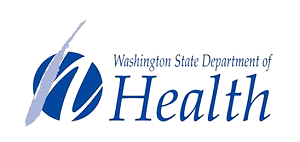
Editor's note: This article was sponsored by the Washington State Department of Health.
Now that the indoor mask requirement in Washington state has been lifted, navigating the new public health landscape can be concerning for parents of children still too young to be vaccinated, says Elias Kass, N.D., a Seattle-based naturopathic doctor specializing in pediatric primary care.
Although Pfizer and BioNTech as well as Moderna are working to finalize COVID-19 vaccine trials for this younger group, there is still no COVID-19 vaccine authorized for children younger than 5, a segment of the population representing more than 460,000 Washington children. While the risk of hospitalization and death from the virus is much lower for children, there are still concerns about the long-term effects of the virus, even for those with a mild case, Kass notes.
“To parents of young kids, I would say, ‘You’re not crazy or overprotective for wanting to shield your child from infection,’” says Kass. “It’s totally reasonable that families may have opted to keep these kids sheltered as the rest of the world opened up.”
This far into the pandemic, parents are well-versed in the tried-and-true strategies we’ve employed during the pandemic to help prevent the spread of the coronavirus. Vaccination offers the best possible protection, but we can depend on wearing masks, vaccinating eligible family members, washing hands frequently, testing regularly, and using tools such as WA Notify (the smartphone app that alerts you when you’ve potentially been exposed to the coronavirus) to keep our unvaccinated kids safe, too.
A roller coaster of hope, disappointment
The U.S. Food and Drug Administration (FDA) authorized the Pfizer-BioNTech vaccine for children ages 5–11 in late October 2021. Many parents were hopeful that authorization for the vaccine for children younger than 5 would quickly follow. But in February, when it postponed a decision on authorizing the Pfizer-BioNTech vaccine for infants and young children, the FDA announced that it wanted more data about a third dose.
Initially, the company had tested a two-dose version of the vaccine for infants and young children. But the smaller size of those doses — 3 micrograms — didn’t trigger a robust immune response. (In comparison, children ages 5–11 receive 10 micrograms per dose; adults receive 30 micrograms per dose.)
Instead of starting from scratch with a higher dose, the company kept the same children enrolled in the trial and added a third dose. Data from the three-dose trial are expected to be released sometime this spring. In the meantime, Moderna — which currently only has an approved vaccine for adults — is also seeking authorization for a two-dose vaccine series for children ages 6 months–6 years, and had previously requested vaccines for kids ages 12–17 last summer. The FDA hasn’t taken any action on that request.
What level of effectiveness is expected for a pediatric vaccine?
While the delay may be confusing, experts say it’s a sign that the FDA is seeking a highly effective vaccine as well as carefully scrutinizing safety outcomes based on the latest available data gathered during the omicron surge. It’s important to roll out the best possible dosage regimen to adequately protect children in this youngest age group, even if that process takes a little longer.
“If it gets authorized, it will be because it works,” says Kass.
Safety is the paramount consideration
While COVID-19-related deaths among the 6 months–4 years age group represent a minuscule percentage of the country’s overall death tally, 464 young children and infants have died (as of April 17), according to the Centers for Disease Control and Prevention (CDC). A total of 3,578 children in this age group have been hospitalized nationwide due to the coronavirus since March 2020 (data as of April 9).
About two-thirds of children hospitalized with COVID-19 had an underlying condition, such as obesity, according to a CDC report that examined cases at six hospitals last summer. Vaccine authorization for this age group would be “exceptionally reassuring” for young patients with preexisting health conditions such as congenital heart disease, says Agustin Rubio, M.D., a pediatric cardiologist at Seattle Children’s Hospital. Along with the elderly and adults with preexisting conditions, these high-risk children can also face the “devastating effects” of COVID-19, he says.
“Having that ability to provide an additional source of protection for our high-risk patients with heart disease would be amazing,” says Rubio.
Over the past two years, providers at Seattle Children’s Hospital have seen a wide spectrum of COVID-19 cases. While many young patients have mild, cold-like symptoms, there have been some children admitted into the critical care unit, requiring additional oxygen to breathe. Overall, vaccinated individuals tend to recover faster. They are also less likely to infect other members of their family, he notes.
“Vaccination provides a sense of freedom,” says Rubio.
That freedom comes from the sense a parent has done everything possible to give their child the best chance at recovery if they become infected. That extra protection can also help ease the family back into more social interactions, which are key for children’s overall development and well-being.
“I think we need to provide them that freedom, freedom that can only come after securing their health,” says Rubio.
A pandemic childhood
In his primary care practice, Kass sees young patients who haven’t experienced life outside of the pandemic. Many parents have limited social exposure to protect their unvaccinated children.
That isolation has come during what can already be a vulnerable time for young families. Kass used to recommend that new parents join support groups, attend baby music classes, get coffee with other parents and head to the playgrounds. During the height of the pandemic, those community-building activities were largely suspended.
Even when communities opened again, some families with children too young to mask still avoided such communal activities. Others chose not to seek help from grandparents, friends or a babysitter, shouldering all child care themselves. Still other families faced the stress of sending older children to school or working outside the home, possibly bringing home an infection to an unvaccinated child.
When Kass discusses vaccination with parents, he explains the broader landscape: This is a virus that’s incredibly contagious — and it mutates.
“It’s not a choice between the vaccine and nothing,” says Kass. “It’s a choice between the vaccine and the disease. Whatever head start our immune system can get is always going to be advantageous.”
While we wait, we know the drill
In the absence of a vaccine for our youngest kids, we can protect them by doubling down on the safeguarding methods we’ve all become accustomed to following during the pandemic.
Washington state Secretary of Health Umair Shah, M.D., MPH, advises, “We do know that vaccination is the best tool we have to prevent severe COVID-19 outcomes. While we don’t know if or when the FDA will authorize a COVID-19 vaccine for children younger than 5, we recommend family members and caregivers get vaccinated and boosted if they have children in this age group. We also encourage parents and caregivers to use other prevention tools if vaccination is not an option, such as wearing a mask in crowded settings, washing little hands frequently, and making sure if anyone is sick that they stay home and get tested for COVID-19.”
|
Sponsored by |
|
|












